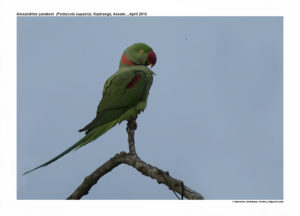
Alexandrine Parakeet Psittacula eupatria
Etymology
- Psittacula : Latin word derived from psittacus – Parrot
- Eupatria: Greek word eupatereia –noble daughter
Vernacular Name: Sind: Takru, Hindi: Raitota, Hiramantota, Pun: Ra tota, U.P:Paharitota, M.P: Karan tota, Ben: Chandana, Lepcha: Ne tso, Nepal: Karan suga, Kararia, Guj: Rajpipla-no popat, Ori: Suva, Swa, Te: Peddachiluka, Mandiramachiluka, Ta: Periyakili, Kan: Doddagini, Sinh: Labugirawa, Mar: Karan Popat
Distribution in India: Resident of peninsular India
Description: Size of 50–62 cm; 198–258 g. It has a Red bill, head is green shading to grey on nape and lower face, black chin and malar, bar to side of neck where it is replaced by broad pink-red bar round hindneck. The upper body is yellow-green shading deeper on wings and belly; long reddish patch on lesser wing-coverts. The tail is green basally shading through pale blue-green to yellowish tip, with outer feathers green with yellowish tips. The female is duller, with no black on chin or pink collar. The Immature is like the female.
Habitat: It is found in dry and moist deciduous lowland forest and wooded areas including mangroves, coconut plantations and old gardens, penetrating desert regions where trees grow by water. Found from low levels to 800 m.
Food habits: It eats fruits,seeds, nectar, fleshy petals, and young leaves of vegetables. The flocks do considerable damage in orchards and ripening cereal crops.
Breeding habits: They breed in Nov–Apr. The nest is in a hole in coconut palm or large softwood tree, sometimes the hardwood, and mangroves. They lay a clutch of 3–4 eggs. The incubation period is 19–21 days.